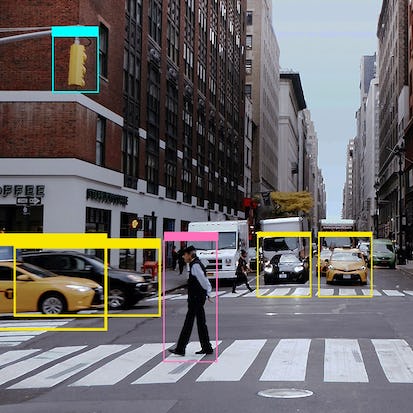- Level Professional
- Duration 14 hours
- Course by MathWorks
-
Offered by

About
In the third and final course of the Computer Vision for Engineering and Science specialization, you will learn to track objects and detect motion in videos. Tracking objects and detecting motion are difficult tasks but are required for applications as varied as microbiology and autonomous systems. To track objects, you first need to detect them. You'll use pre-trained deep neural networks to perform object detection. You'll also use optical flow to detect motion and use the results to detect moving objects. At the end of this course, you'll apply all the skills learned in this specialization to a final project. You'll take the role of an engineer being asked to track cars on a busy highway with the added challenge of counting each vehicle and its direction. You will use MATLAB throughout this course. MATLAB is the go-to choice for millions of people working in engineering and science and provides the capabilities you need to accomplish your computer vision tasks. You will be provided free access to MATLAB for the course duration to complete your work. To be successful in this specialization, it will help to have some prior image processing experience. If you are new to image data, it's recommended to first complete the Image Processing for Engineering and Science specialization.Modules
Welcome to the Course
2
Videos
- Computer Vision for Engineering and Science
- Introduction to Object Tracking and Motion Detection
2
Readings
- Meet Your Instructors
- Course files and MATLAB
Object Detection Using Pretrained Models
1
Discussions
- Share Your YOLO Results
1
Videos
- Detecting Objects with Pretrained Models
1
Readings
- Using Pre-trained Deep Learning Models
Object Detection Using Segmentation
1
Discussions
- Segmentation or Deep Learning?
1
Videos
- Detecting Objects with Segmentation
1
Readings
- Review of Segmentation
Module 1 Assessment
1
Assignment
- Graded Quiz: Using the YOLO pre-trained model
1
External Tool
- Project: Segment an Image
1
Readings
- Module Assessment
Introduction to Motion Detection
1
Assignment
- Concept Check: Introduction to Motion Detection
1
Videos
- Detecting Motion
Detecting Motion with Template Matching
1
Videos
- Stabilizing Video with Template Matching
1
Readings
- Considerations when Template Matching
Motion Detection with Optical Flow
1
Assignment
- Graded Quiz: Detecting Motion
1
Videos
- Applying Optical Flow
1
Readings
- Practice Applying Optical Flow
Module Project: Applying Optical Flow
2
External Tool
- Project: Applying Optical Flow to Detect Moving Objects
- Project: Applying Optical Flow to Determine the Direction of Traffic
1
Readings
- Project: Introduction to Applying Optical Flow to Determine the Direction of Traffic
Introduction to Object Tracking
1
Assignment
- Concept Check: Object Tracking
2
Videos
- Introduction to Object Tracking
- Implementing Object Tracking 1: Concepts
Implementing Object Tracking
1
Assignment
- Graded Quiz: Object Tracking
1
Discussions
- Interesting Results and Ideas
1
Videos
- Implementing Object Tracking 2: Execution
2
Readings
- Reference: Important Tracking Parameters
- Example: Tracking Cells
Traffic Flow Project: Detection
1
Assignment
- Concept Check: Detecting Cars
1
Videos
- Introduction to the Traffic Flow Project
1
Readings
- Final Project Part 1: Detecting Cars
Traffic Flow Project: Count Total Cars
1
Assignment
- Project: How many cars did you track?
1
Readings
- Final Project Part 2: Counting Cars
Traffic Flow Project: Count Cars in Each Direction (Optional)
1
Assignment
- Project: Determining Track Direction
1
Discussions
- Share Your Tracking Results
1
Readings
- Final Project Part 3: Determining Track Direction
1
Quiz
- Project: Determining Track Direction
Specialization Summary
2
Videos
- Integrating Your Code
- Summary of Computer Vision for Engineering and Science
1
Readings
- What's Next?!
Auto Summary
Discover how to master object tracking and motion detection in videos with the "Object Tracking and Motion Detection with Computer Vision" course, the concluding segment of the Computer Vision for Engineering and Science specialization. This professional-level course delves into the sophisticated techniques required to track objects and detect motion, essential for fields ranging from microbiology to autonomous systems. Guided by expert instruction, you will learn to leverage pre-trained deep neural networks for object detection and utilize optical flow for motion detection, culminating in identifying moving objects. The practical application of these skills is demonstrated through a final project where you will track and count vehicles on a busy highway, providing a comprehensive, hands-on learning experience. Throughout the course, you will use MATLAB, a leading tool in engineering and science, with free access provided for the course duration. Prior image processing experience is beneficial, and beginners are encouraged to first complete the Image Processing for Engineering and Science specialization. This engaging 840-minute course, offered by Coursera, is designed for professionals seeking to enhance their expertise in computer vision. With flexible subscription options, this course is ideal for those aiming to advance their skills in a dynamic and rapidly evolving domain.

Amanda Wang

Matt Rich

Brandon Armstrong

Megan Thompson

Isaac Bruss


